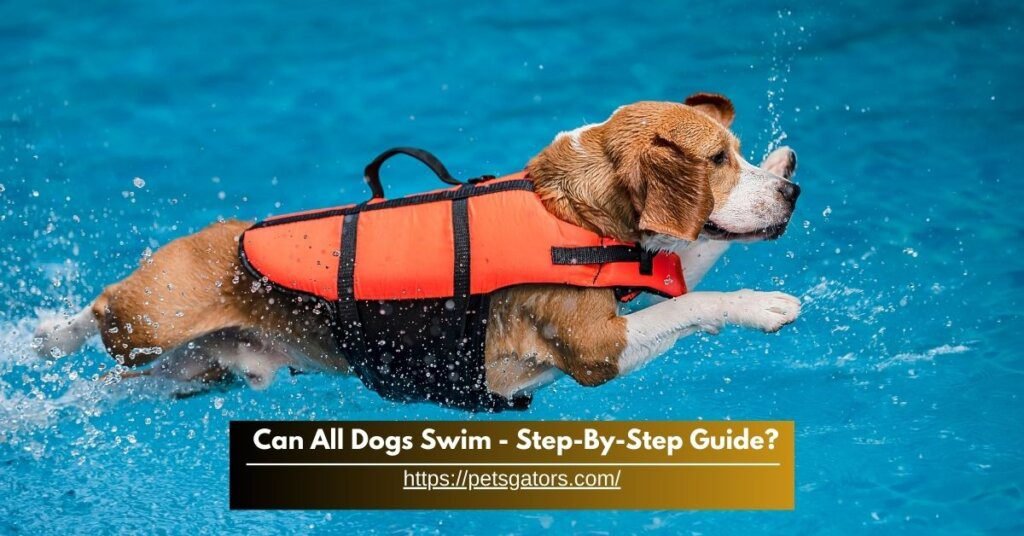Dogs and water can be a great combination! Many dogs love playing in the water and swimming. But not all dogs swim naturally. Some dogs need help feeling comfortable in the water. Others need to learn how to swim safely. Teaching your dog to swim can be both enjoyable and beneficial. It offers excellent exercise and mental engagement. Swimming can also be a lifesaving skill for dogs. With patience and practice, any dog can learn to swim. In this guide, we will show you how to teach your dog to swim in a safe and supportive way.
Building Trust and Confidence in the Swimming Process
Dogs and water can be a great team. Many dogs love playing in the water and swimming. Some dogs are natural swimmers, with bodies built for the water.
Labradors and Golden Retrievers are super swimmers. They have strong tails, water-resistant coats, and a natural instinct to paddle.
Other breeds might need more time and practice to get comfortable in the water. Small dogs, big dogs, and dogs with health issues might face challenges when swimming.
But with patience and practice, many dogs can learn to swim safely and confidently. Swimming is great exercise, mental stimulation, and a new way to play.
It can even be a lifesaver for dogs! Teaching your dog to swim takes a gradual and supportive approach.
Building trust and confidence in the water is crucial. Start with small steps, like getting your dog used to the sight and sound of water
Can All Dogs Swim?
Dogs and water can be a great combination! Many dogs love playing in the water and swimming. Some dogs are born to swim, with bodies perfectly suited for the water.
Breeds like Labradors and Golden Retrievers are known for their swimming abilities. They have strong tails, water-resistant coats, and a natural instinct to paddle.
But other breeds may not be as comfortable in the water. Some dogs may be too small, too large, or have health conditions that make swimming difficult.
Despite these challenges, many dogs can still learn to swim with patience and practice. Introducing your dog to swimming can be an enjoyable and fulfilling activity.
It provides exercise, mental stimulation, and a new way to play. Swimming can also be a lifesaving skill for dogs.
How to Prepare Your Dog for Swimming
Step 1: Get Your Dog Used to Water
Start by introducing your dog to small amounts of water, such as a kiddie pool or a shallow dish. Let them explore and get comfortable with the sight, sound, and feel of water. Create a positive experience by providing treats and praise.
Step 2: Teach Your Dog to Enter and Exit the Pool Safely
Show your dog how to enter and exit the pool safely. Start with small steps, like getting them to put their paws in the water and then gradually increasing the depth. Encourage them to use the pool stairs or a ramp to exit the pool.
Step 3: Build Confidence in the Water
Once your dog is comfortable entering and exiting the pool, it’s time to build their confidence in the water. Start with short sessions, such as 5-10 minutes, and gradually increase the time as they become more comfortable. Encourage them to paddle and play in the water.
Step 4: Practice Swimming Short Distances
Once your dog is confident in the water, it’s time to practice swimming short distances. Start with short distances, such as 5-10 feet, and gradually increase the distance as they become more comfortable. Encourage them to swim to you or a toy.
Step 5: Teach Your Dog to Follow Basic Commands in the Water
Teach your dog to follow basic commands, such as “stay,” “come,” and “leave it,” in the water. This will help them understand what you want them to do and keep them safe.
Step 6: Ensure a Safe and Supportive Environment
Always keep an eye on your dog when they are near or in the water. Provide a safe and supportive environment by ensuring the pool or beach is dog-friendly and free from hazards.
Safety Considerations
- When it comes to swimming with your dog, safety.
- Always watch your dog closely when they are in or near the water.
- Make sure the pool or beach is dog-friendly and free from hazards.
- Check the water depth and temperature before letting your dog swim.
- Begin with brief sessions and slowly extend the duration as your dog grows more at ease.
- Watch for signs of exhaustion or stress, like panting or struggling.
- If you notice any of these signs, get your dog out of the water right away.
- Keep a close eye on your dog at all times, especially near pool drains or strong currents.
- Never leave your dog unsupervised while they’re in the water.
- Teach your dog basic water safety skills, like entering and exiting the pool safely.
- Be aware of your dog’s swimming abilities and limitations.
- Provide a safe and supportive environment for your dog to enjoy swimming.
- Always prioritize your dog’s safety and well-being.
Tips and Tricks
1. Make Swimming Fun for Your Dog
Start slow, use positive reinforcement, and make swimming a game to help your dog feel comfortable and confident in the water.
2. Incorporate Swimming into the Exercise Routine
Mix up exercises, schedule regular swimming sessions, and monitor your dog’s progress to keep them engaged and prevent boredom.
3. Find Dog-Friendly Swimming Locations
Research local dog parks, beaches, and pools, and always be respectful of rules and other swimmers to ensure a safe and enjoyable experience for your dog.
Conclusion
Swimming is a great activity for dogs, but not all dogs swim naturally. With patience, practice, and positive reinforcement, many dogs can learn to swim safely and confidently. Remember to start slow, build trust, and provide a supportive environment. Always prioritize your dog’s safety and well-being. Research local dog-friendly swimming spots and follow the rules and guidelines. Swimming offers an enjoyable and fulfilling experience for both you and your dog. It provides exercise, mental stimulation, and a new way to play.
Following the steps outlined in this guide can help your dog become a happy and confident swimmer. Don’t be discouraged if your dog doesn’t go swimming right away. Every dog is different, and some may need more time and practice. With consistency and patience, you can help your dog overcome fears and build confidence in the water.
FAQ’s
Q1: Can any dog learn to swim?
A: Yes, most dogs can learn to swim with help and practice. Some dogs might need more time or help, but many can learn.
Q2: How old should my dog be to start swimming?
A: Puppies can start getting used to water when they’re about 2-3 months old. But they should be at least 6 months old before they start swimming lessons. Adult dogs can start swimming at any age.
Q3: What if my dog is scared of water or can’t swim?
A: That’s okay! Start with small steps. Get their paws wet or play with water in a shallow area. Help them get comfortable and confident. If they still struggle, ask a professional for help.
Q4: Can I teach my dog to swim by myself?
A: You can try, but it’s better to work with a professional. They can help you and your dog stay safe and make sure your dog learns to swim well. They can also give you good tips and advice.
Also Must Read More: How To Teach A Dog To Swim – Dog Swimming Guide







